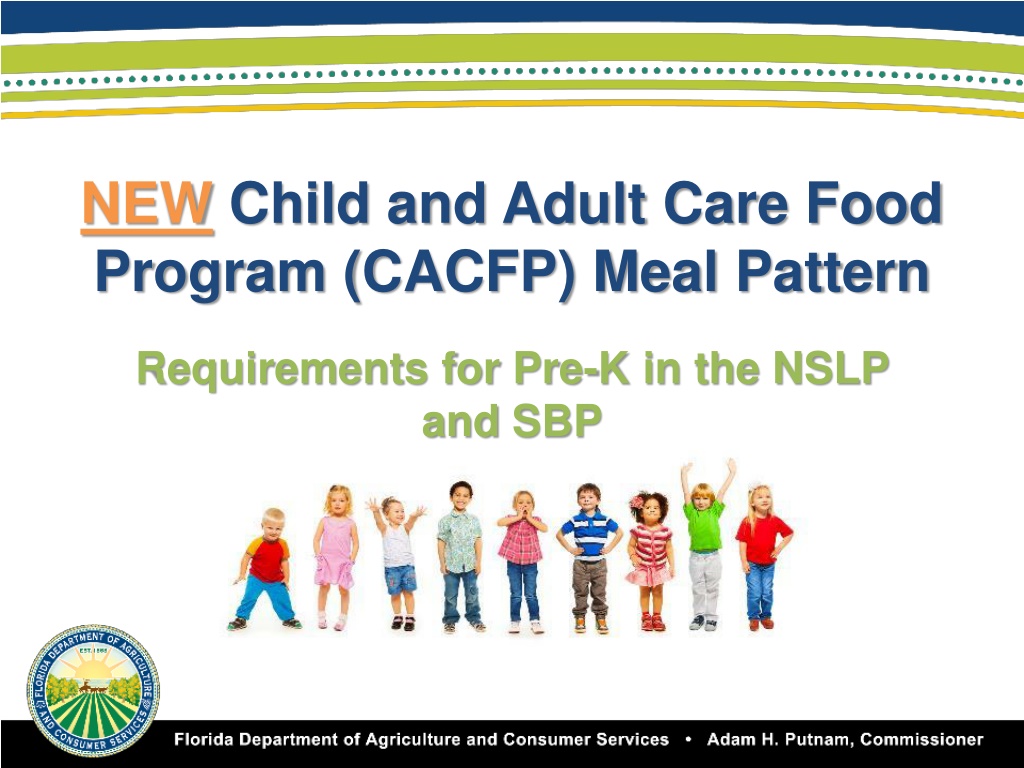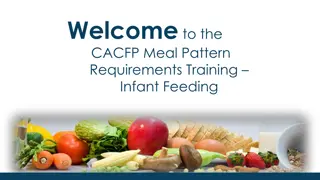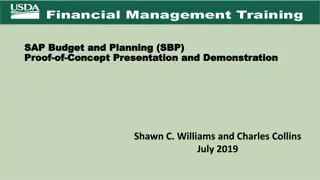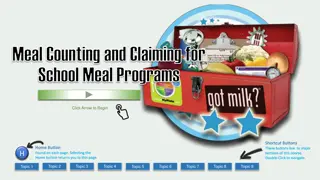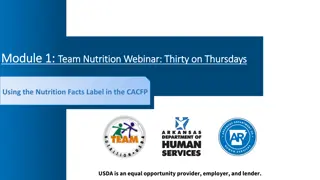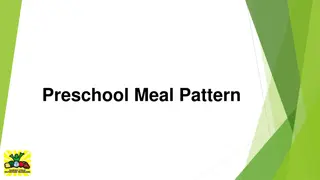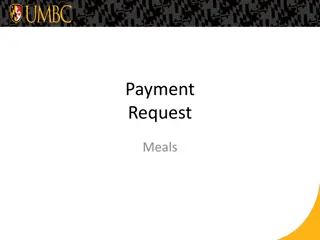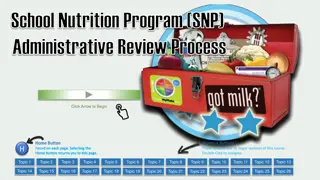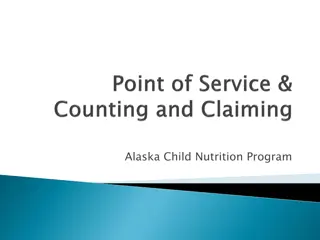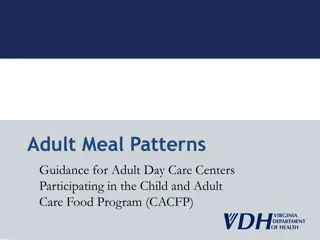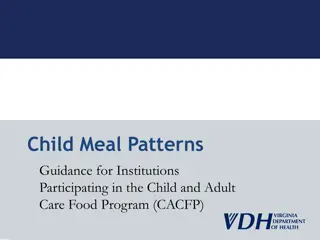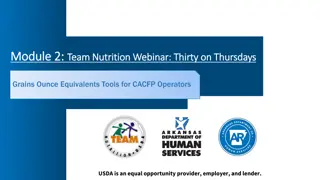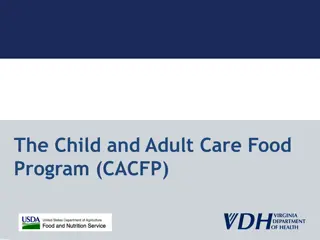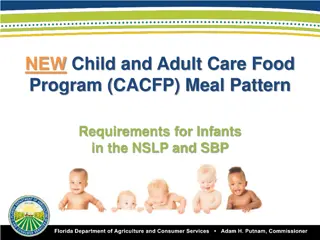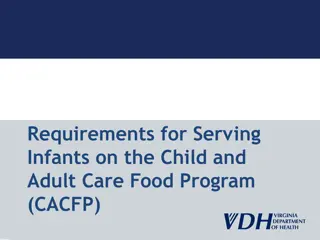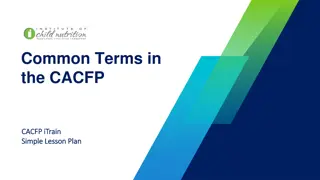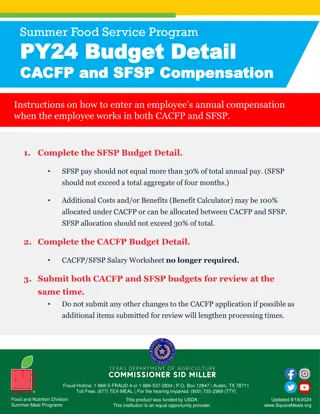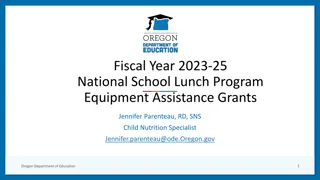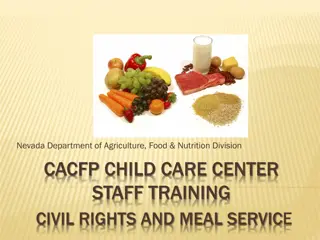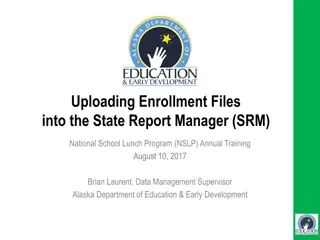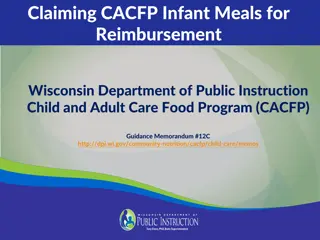Understanding CACFP Meal Pattern Requirements for Pre-K in NSLP and SBP
Explore the new Child and Adult Care Food Program (CACFP) meal pattern requirements for Pre-K students in the National School Lunch Program (NSLP) and School Breakfast Program (SBP). Learn about regulatory processes, implementation plans, age group clarifications, and key takeaways for providing nutritious breakfast meals to preschoolers. Discover details on serving components, milk requirements, whole grains, and restrictions on grain-based desserts. Stay compliant with updated guidelines for serving quality meals to young children.
Download Presentation

Please find below an Image/Link to download the presentation.
The content on the website is provided AS IS for your information and personal use only. It may not be sold, licensed, or shared on other websites without obtaining consent from the author. Download presentation by click this link. If you encounter any issues during the download, it is possible that the publisher has removed the file from their server.
E N D
Presentation Transcript
NEW Child and Adult Care Food Program (CACFP) Meal Pattern Requirements for Pre-K in the NSLP and SBP
Overview NEW Preschool Meal Patterns USDA Questions & Answers Best Practices Test Your Knowledge *Please refer to the notes section at the bottom of each slide as you review this training.
Regulatory Process Comment period and development of final rule Proposed Rule published: January 15, 2015 Final Rule published: April 25, 2016 Implementation: October 1, 2017
Implementation Plan ALL sponsors serving preschool students must be in compliance with the new preschool meal pattern requirements discussed in this training by October 1, 2017. Sponsors may implement the new preschool meal pattern requirements on the 1st day of the 2017-2018 school year. Reminder: Prior to October 1, 2017, implementation of any new meal pattern practices that conflict with the current preschool meal pattern is not permitted.
Clarification on the Preschool Grade Group Children 1-4 years of age are considered to be in the preschool age group in the NSLP and SBP. In situations where a 5 year old is in preschool or a 4 year old is in kindergarten, a sponsor may continue to serve the meal pattern appropriate for that grade. The final rule maintains the flexibility to serve a single menu when preschool and elementary school students are in the same cafeteria at the same time.
NEW Preschool Meal Patterns Breakfast
Key Takeaways: Preschool Breakfast All three components must be served for a reimbursable meal. MILK must be unflavored whole milk for children age 1 or unflavored low-fat (1%) or unflavored fat-free (skim) milk for preschool children. Flavored milk is not allowed! At least ONE serving of grains per day, across all eating occasions, must be whole grain-rich. GRAIN-BASED DESSERTS do not count towards meeting the grains component for any meal or snack. OUNCE EQUIVALENTS (oz. eq.) will be used to determine the amount of creditable grains (starting October 1, 2019).
Defining Grain-Based Desserts The final rule defines grain-based desserts as those foods in USDA s Food Buying Guide for Child Nutrition Programs Exhibit A, which are denoted with superscripts 3 and 4. The following are no longer allowed in a reimbursable meal for preschool students: Effective October 2019 Sweet crackers (graham crackers, animal crackers) Cookies Sweet pie crust (Dessert pies, cobbler, fruit turnovers) Doughnuts (Frosted and unfrosted) Sweet rolls (Frosted and unfrosted) Toaster pastries (Frosted and unfrosted) Granola bars (Plain or with add-ins) Cake Brownies
Additional Key Takeaways: Preschool Breakfast JUICE is limited to once per day (including snack). Meat and meat alternates may substitute the ENTIRE grains component at breakfast a maximum of three times per week. YOGURT must contain no more than 23 grams of sugar per 6 ounces. BREAKFAST CEREALS must contain no more than 6 grams of sugar per dry ounce. The final rule reduces added sugar consumption by placing maximum limits on sugar in breakfast cereals and yogurts.
NEW Preschool Meal Patterns Lunch and Supper
Key Takeaways: Preschool Lunch and Supper All five components must be served for a reimbursable meal. MILK must be unflavored whole milk for children age 1 or unflavored low-fat (1%) or unflavored fat-free (skim) milk for preschool children. Flavored milk is not allowed! At least ONE serving of grains per day, across all eating occasions, must be whole grain-rich. GRAIN-BASED DESSERTS do not count towards meeting the grains component for any meal or snack. OUNCE EQUIVALENTS (oz. eq.) will be used to determine the amount of creditable grains (starting October 1, 2019).
Additional Key Takeaways: Preschool Lunch and Supper JUICE is limited to once per day (including snack). A vegetable may be used to meet the ENTIRE fruit requirement. When TWO VEGETABLES are served at lunch or supper, two DIFFERENT kinds must be served (e.g. broccoli and carrots). ALTERNATE PROTEIN PRODUCTS must meet the requirements in Appendix A Part 226. YOGURT must contain no more than 23 grams of sugar per 6 ounces. BREAKFAST CEREALS must contain no more than 6 grams of sugar per dry ounce.
Key Takeaways: Preschool Snack Select TWO of the FIVE components for a reimbursable snack. Only one of the components may be a beverage. MILK must be unflavored whole milk for children age 1 or unflavored low-fat (1%) or unflavored fat-free (skim) milk for preschool children. Flavored milk is not allowed! At least ONE serving of grains per day, across all eating occasions, must be whole grain-rich. GRAIN-BASED DESSERTS do not count towards meeting the grains component for any meal or snack. OUNCE EQUIVALENTS (oz. eq.) will be used to determine the amount of creditable grains (starting October 1, 2019).
Additional Key Takeaways: Preschool Snack JUICE is limited to once per day (including snack). ALTERNATE PROTEIN PRODUCTS must meet the requirements in Appendix A Part 226. YOGURT must contain no more than 23 grams of sugar per 6 ounces. BREAKFAST CEREALS must contain no more than 6 grams of sugar per dry ounce.
Additional Provisions The final rule removed the option to use offer versus serve (OVS) for meals served to children 0 through 4 years old in the NSLP and SBP. Generally, OVS is not considered to be appropriate for preschool children because it may interfere with child nutrition program goals and the school s efforts to introduce new foods to children. The new preschool meal patterns also prohibit the use of food and beverages as a reward or punishment.
USDA Questions and Answers: Grains
Questions and Answers 1. Do schools have the discretion to choose which meals will include a whole grain-rich grain for preschool students? Yes, schools may choose to serve a whole grain-rich item at any meal or snack for preschool students as long as one grain per day over the course of all the meals and snacks served that day is whole grain-rich. For example, a school may serve a whole grain-rich cereal at breakfast one day and a whole grain-rich pasta at lunch the next day. This will help expose participants to a variety of whole grains and the wide range of vitamins and minerals whole grains provide.
Questions and Answers 2. Why are grain-based desserts no longer allowed to contribute to the grain component of a meal? The Dietary Guidelines for Americans (Dietary Guidelines) identify grain-based desserts as sources of added sugars and saturated fats and recommends Americans reduce their consumption of added sugars and saturated fats. The Healthy, Hunger-Free Kids Act of 2010 required USDA to revise the CACFP meal patterns to better align them with the Dietary Guidelines. Therefore, in order to be more consistent with the Dietary Guidelines, grain-based desserts cannot be counted towards the grain components in CACFP, (which applies to preschool children in the NSLP and SBP), starting October 1, 2017.
Questions and Answers 3. Are homemade granola bars or other homemade grain-based desserts allowed? No, homemade and commercially prepared grain-based desserts cannot count towards the grain component in CACFP starting October 1, 2017. There are no exceptions to allow a grain-based dessert to count towards the grain component, including the place of preparation or the preparation method. 4. Are quick breads, such as banana breads and zucchini bread, still allowed? Yes, quick breads are credited in the same group as muffins under Group D in Exhibit A, and both may continue to contribute towards the grain component.
Questions and Answers 5. Pancakes and waffles are not grain-based desserts according to Exhibit A. If syrup, honey, jam or another sweet topping is served with the pancakes or waffles, are they then considered grain-based desserts? No, adding a sweet topping, such as syrup, to pancakes or waffles does not make them grain-based desserts and they can continue to be counted towards the grain component. However, FNS strongly encourages schools to explore healthier alternatives for toppings, such as fruit or yogurt. Minimizing sweet toppings will help reduce children s and adults consumption of added sugars. When sugars are added to foods and beverages to sweeten them, they add calories without contributing essential nutrients.
Questions and Answers 6. When submitting menus for review, do schools need to document which grain foods are whole grain-rich? Yes, starting no later October 1, 2017, schools must document when a food is whole grain-rich on their menu and may do this by using terms such as whole grain-rich, whole wheat, or simply listing a whole grain. For example, a menu may say: peanut butter and jelly sandwich on whole grain-rich bread, whole wheat pasta and chicken, or brown rice and vegetables. Common and usual names for whole grains that are helpful to know and can be used to identify whole grain-rich foods on menus are: The word whole listed before a grain (e.g. whole wheat or whole corn); The words berries and groats are used to designate a whole grain, such as wheat berries or oat groats; Rolled oats and oatmeal (including old fashioned, quick cooking, and instant oatmeal); and Other whole-grain foods that do not use the word whole in their description, such as brown rice, brown rice flour, wild rice, quinoa, millet, triticale, teff, amaranth, buckwheat, and sorghum.
Questions and Answers 7. If a program only serves snacks to preschool students, would all the grains served at snack have to be whole grain- rich? Yes, if the snack includes a grain, such as crackers with apples, the grain must be whole grain-rich starting October 1, 2017. However, programs that only serve snack are not required to serve a grain at snack because it is not a required component at snack. A program may offer a reimbursable snack with a fruit and vegetable, milk and fruit, a meat alternate and vegetable, and so forth. Conversely, if a school only serves one meal (breakfast, lunch or supper) to preschool students per day then the grain served at that meal must be whole grain-rich.
USDA Questions and Answers: Milk
Questions and Answers 1. Can sponsors stop serving flavored milk to preschool children prior to October 1, 2017? Yes, sponsors may stop serving flavored milk to preschool children immediately, and no later than October 1, 2017. This provision is consistent with the current meal pattern requirements so sponsors may begin to follow them at any time, but no later than October 1, 2017.
Questions and Answers 2. If one year old and two year old children sit together for the same meal, must they be served different types of milk? Yes, by October 1, 2017 children two years old and older must be served unflavored low-fat or unflavored fat-free milk and children one year of age must be served unflavored whole milk. The fluid milk requirements are based on age to ensure that children are receiving the nutrients they need for growth and development. Schools must ensure that children of various ages seated together receive the appropriate type of milk.
Questions and Answers 3. Are meals served to children 1 year old and older reimbursable if they contain infant formula? Yes, for a period of one month, when children are 12 to 13 months of age, meals that contain infant formula may be reimbursed to facilitate the weaning from infant formula to cow s milk. While weaning, infants should be presented with both types of foods at the same meal service to gradually encourage the acceptance of the new food. Breastmilk continues to be considered an acceptable fluid milk substitute for children over 12 months of age. Meals containing infant formula that are served to children 13 months and older are reimbursable when supported by a medical statement signed by a recognized medical authority. The statement must explain the need for the substitution and must be kept on file by the school.
USDA Questions and Answers: Fruits and Vegetables
Questions and Answers 1. Can two servings of broccoli be served at lunch to fulfill the vegetable component and fruit component? No, two servings of broccoli to meet the vegetable component and fruit component would not be reimbursable under the updated lunch and supper preschool meal patterns. While schools may serve two servings of vegetables at lunch and supper, the two servings of vegetables must be different. This is designed to be consistent with the Dietary Guidelines recommendation that all Americans should consume a variety of vegetables. The two servings of vegetables do not need to be from different subgroups (e.g., dark green vegetables, red and orange vegetables, starchy vegetables, beans and peas (legumes), or other vegetables). For example, a lunch or dinner with a serving of carrots and a serving of red bell peppers (both red and orange vegetables) would be allowable. Although serving vegetables from different subgroups is not a requirement for preschool students, offering a variety of vegetables can help improve the overall nutritional quality of the meals served to participants.
Questions and Answers 2. How do raw leafy greens contribute to the vegetable component? Similarly, how does dried fruit contribute to the fruit component? One cup of leafy greens (e.g., lettuce, raw spinach, etc.) counts as cup of vegetables and cup dried fruit counts as cup of fruit under the updated preschool meal patterns, which go into effect on October 1, 2017. This is consistent with the National School Lunch and School Breakfast Programs. 3. With separate vegetable and fruit components at lunch, supper, and snack in the updated preschool meal patterns, how do food items that are mixtures of vegetables and fruit, such as a carrot-raisin salad, credit? Food items that are mixtures of vegetables and fruits, such as a carrot-raisin salad, can only credit towards the vegetable component or the fruit component, not both, at lunch, supper and snack. For a mixed food item to credit towards the vegetable component or fruit component, it must contain at least cup vegetable or fruit per serving.
Questions and Answers 4. Can a 100 percent fruit and vegetable juice blend be served to fulfill both the vegetable component and the fruit component? One hundred percent fruit and vegetables juice blends are allowable, but they cannot fulfill both the vegetable component and fruit component in the same meal. Similar to the National School Lunch and School Breakfast Programs, a 100 percent fruit and vegetable blend may contribute to the fruit component when fruit juice or puree is the most prominent ingredient; and a 100 percent fruit and vegetable blend may contribute to the vegetable component when vegetable juice or puree is the most prominent ingredient. Keep in mind that fruit or vegetable juice may not be served to infants and may only be served once per day to children 1 year old and older.
Best Practices Make at least 1 of the 2 required components of a snack a vegetable or a fruit. Serve a variety of fruits and choose whole fruits (fresh, canned, dried or frozen) more often than juice. Provide at least one serving per week of each vegetable subgroup: Dark green vegetables Red and orange vegetables Beans and peas (legumes) Starchy vegetables Other vegetables
Best Practices Provide at least two servings of whole grain-rich grains per day. Serve only lean meats, nuts, and legumes. Limit serving processed meats to no more than one serving per week. Serve only natural cheeses and choose low-fat or reduced fat-cheeses.
Best Practices Incorporate seasonal and locally produced foods into meals. Limit serving purchased, pre-fried foods to no more than one serving per week. Avoid serving non-creditable foods that are sources of added sugars, such as sweet toppings (e.g., honey, jam, syrup) and mix-in ingredients sold with yogurt (e.g., honey or candy pieces).
Test Your Knowledge! Question 1: True or False? When two vegetables are served at lunch or supper, two different kinds of vegetable subgroups must be served. Question 2: True or False? Flavored milk of any kind is not allowed to be served to preschool children. Question 3: True or False? Pasteurized full-strength juice may only be used to meet the fruit or vegetable requirement at one meal, including snack, per day. Question 4: True or False? Grain-based desserts may only credit towards the grain component at one meal, including snack, per day. Question 5: True or False? The final rule removed the option to use offer versus serve (OVS) for meals served to children 0-4 years old in the NSLP and SBP. Click the next slide to check your answers!
Test Your Knowledge! Question 1: When two vegetables are served at lunch or supper, two different kinds of vegetable subgroups must be served. FALSE Question 2: Flavored milk of any kind is not allowed to be served to preschool children. TRUE Question 3: Pasteurized full-strength juice may only be used to meet the fruit or vegetable requirement at one meal, including snack, per day. TRUE Question 4: Grain-based desserts may only credit towards the grain component at one meal, including snack, per day. FALSE Question 5: The final rule removed the option to use offer versus serve (OVS) for meals served to children 0-4 years old in the NSLP and SBP. TRUE
Questions? Monica Figueroa, MS, RD Nutrition Standards Program Specialist (850) 617-7450 | Monica.Figeuroa@FreshFromFlorida.com Sydney Kelly, RDN Nutrition Standards Program Specialist (850) 617-7462 | Sydney.Nutting@FreshFromFlorida.com This institution is an equal opportunity provider. 07/17
